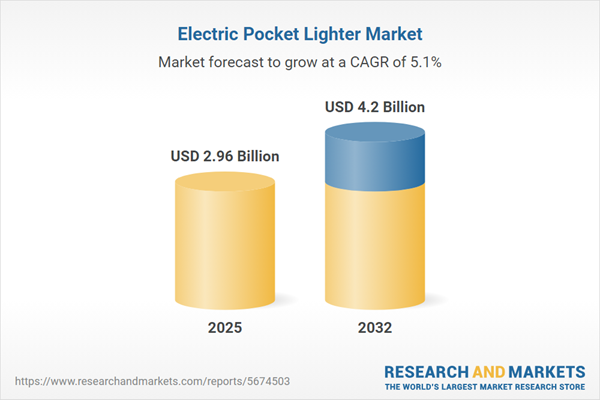Speak directly to the analyst to clarify any post sales queries you may have.
The electric pocket lighter market is undergoing rapid transformation as industry leaders confront evolving regulations and prioritize both supply chain efficiency and innovative, sustainable product solutions. Senior executives are facing new operational challenges and opportunities that stem from shifting consumer preferences, regulatory demands, and the push for technical advancements.
Market Snapshot: Electric Pocket Lighter Market Growth
The global electric pocket lighter market is set for steady expansion, projected to advance from USD 2.82 billion in 2024 to USD 4.20 billion by 2032. With a compound annual growth rate (CAGR) of 5.11%, this sector is fueled by continuous innovation in flameless and rechargeable lighter technologies, alongside strategic investments in enhanced safety features. Manufacturers are increasingly focused on evolving component designs and optimized manufacturing, which bolster adoption across both mature and developing markets. Emphasis on responsibly sourced rechargeable components and agile product strategies aligns with ongoing compliance requirements. The extension of distribution networks and robust product development pipelines helps suppliers address region-specific demands and stay responsive in a shifting competitive landscape.
Scope & Segmentation
- Distribution Channels: Direct sales networks span specialty stores, supermarkets, convenience retailers, and digital platforms, empowering organizations to strengthen retail reach and scale procurement initiatives across multiple environments.
- Technology Types: Integration of single arc, double arc, and multiple arc ignition systems serves a broad range of user preferences, from focused safety improvements to tailored solutions for both professional and everyday uses.
- Price Ranges: Options from economy to mid-tier and premium categories enable procurement leaders to flexibly allocate budgets according to varied buyer profiles and organizational goals.
- End User Segments: Commercial buyers leverage electric pocket lighters for branding, gifting, and promotional campaigns, while individual consumers drive advancements in personalization and design diversity.
- Application Areas: The technology finds application in organizational gifting, promotional activities, and outdoor events, establishing its role in both business-to-business and business-to-consumer procurement strategies.
- Geographical Coverage: The Americas, Europe, Asia-Pacific, and Middle East & Africa each exhibit unique market conditions, compliance environments, and consumer expectations, highlighting the necessity for regionalized approaches and innovation.
- Leading Companies: BIC Corporation, Zippo Manufacturing Company, S.T. Dupont International S.A., Newell Brands Inc., Colibri Group LLC, Ronson Consumer Products LLC, Shenzhen Huanmao Technology Co., Ltd., Shenzhen Qianfen Trading Co., Ltd., Shenzhen SUQMAI Technology Co., Ltd., and Guangzhou Lica Technology Co., Ltd. continue to expand their influence through optimized supply networks and global strategies.
Key Takeaways for Decision-Makers
- Growing preference for rechargeable, windproof, and resilient lighter models underpins usage across operational, recreational, and gifting scenarios in varied sectors.
- Progress in battery and ignition technology facilitates regulatory compliance and ensures product performance in different operating environments.
- Diversified product ranges centered around gifting, branding, and promotion enhance flexibility for organizations targeting new revenue streams.
- Strengthening both online and physical distribution platforms enhances supply chain resilience and allows rapid adaptation to changing enterprise or consumer demand.
- Differentiated pricing structures create efficient paths for bulk procurement, supporting scalability for a spectrum of business needs.
- Adapting core supply, production, and compliance frameworks to meet region-specific regulatory and market requirements is fundamental for maintaining business continuity.
Tariff Impact
Recent tariff adjustments in the United States have increased costs for essential lighter components and materials. To address these shifts, manufacturers are prioritizing regional sourcing, expanding local production capabilities, and accelerating compliance processes to reduce risk and support uninterrupted operations.
Methodology & Data Sources
This research is based on secondary sources from leading industry publications, regulatory repositories, and market intelligence platforms. Inputs from manufacturers and distributors, as well as scenario analysis and benchmarking, support recommendations and ensure adaptability to evolving market requirements.
Why This Report Matters
- Equips senior leadership with the actionable insights needed to navigate regulatory change and optimize procurement in the electric pocket lighter sector.
- Clarifies operational and compliance complexities, supporting organizations as they plan for efficiency and resilience in their supply chain and sourcing strategies.
- Links emerging technologies and distribution approaches to quantifiable business outcomes, helping organizations refine their market approach and achieve stronger positioning.
Conclusion
Securing sustained growth in the electric pocket lighter market requires relentless innovation, proactive compliance, and agile distribution strategy. Aligning these focus areas enables organizations to adapt confidently and prosper in a dynamic competitive landscape.
Additional Product Information:
- Purchase of this report includes 1 year online access with quarterly updates.
- This report can be updated on request. Please contact our Customer Experience team using the Ask a Question widget on our website.
Table of Contents
3. Executive Summary
4. Market Overview
7. Cumulative Impact of Artificial Intelligence 2025
List of Figures
Companies Mentioned
The companies profiled in this Electric Pocket Lighter market report include:- BIC Corporation
- Zippo Manufacturing Company
- S.T. Dupont International S.A.
- Newell Brands Inc.
- Colibri Group LLC
- Ronson Consumer Products LLC
- Shenzhen Huanmao Technology Co., Ltd.
- Shenzhen Qianfen Trading Co., Ltd.
- Shenzhen SUQMAI Technology Co., Ltd.
- Guangzhou Lica Technology Co., Ltd.
Table Information
| Report Attribute | Details |
|---|---|
| No. of Pages | 189 |
| Published | November 2025 |
| Forecast Period | 2025 - 2032 |
| Estimated Market Value ( USD | $ 2.96 Billion |
| Forecasted Market Value ( USD | $ 4.2 Billion |
| Compound Annual Growth Rate | 5.1% |
| Regions Covered | Global |
| No. of Companies Mentioned | 11 |









